Journal list menu
Export Citations
Download PDFs
Editor's Choice
Editorials
Shared decision making in dermatology: asking patients, ‘What is important to you?’
- Pages: 759-760
- First Published: 15 April 2014
The outstanding record of clinical trials in the British Journal of Dermatology
- Pages: 761-763
- First Published: 15 April 2014
Commentary
The association between beta-blockers and melanoma survival: evidence of absence or absence of evidence?
- Pages: 764-765
- First Published: 15 April 2014
ORIGINAL ARTICLE, p 930
Putting papers into practice
How effective is intralesional injection of triamcinolone acetonide compared with topical treatments in inducing and maintaining hair growth in patients with alopecia areata? A Critically Appraised Topic
- Pages: 766-771
- First Published: 01 February 2014
Review articles
Diagnosing and treating psoriatic arthritis: an update
- Pages: 772-786
- First Published: 23 November 2013
What's already known about this topic?
- Psoriatic arthritis (PsA) is a significant comorbidity of psoriasis.
- Physical disability, cardiovascular comorbidities, psychological issues, and a generally poor quality of life negatively impact many to most patients with PsA.
- Several tools have been developed to aid in PsA diagnosis and assessment.
- A large body of work has been devoted to researching factors contributing to PsA and developing targeted biologic therapies.
What does this study add?
- Dermatologists are in a position to recognize the early signs of PsA and therefore can be instrumental in achieving the goal of early initiation of adequate therapy.
- Early intervention may also help slow disease progression and improve patient outcomes.
- This review may be used by dermatologists as an educational guide on the pathogenesis, screening, diagnosis, comorbidities, existing treatments and emerging therapies for PsA.
Socioeconomic status and cutaneous malignant melanoma in Northern Europe
- Pages: 787-793
- First Published: 20 December 2013
What's already known about this topic?
- Socioeconomic status (SES) is associated with cutaneous malignant melanoma (CMM) in Northern Europe despite equal access to health care.
- It is not SES per se but risk factors for CMM that are responsible for this association.
What does this study add?
- Intermittent ultraviolet radiation exposure from sun holidays, and possibly more knowledge and better understanding of CMM may be responsible for the increased incidence registered and decreased mortality from CMM among high SES individuals.
Original articles
Clinical and laboratory investigations
Long-term effectiveness of intralesional triamcinolone acetonide therapy in orofacial granulomatosis: an observational cohort study
- Pages: 794-801
- First Published: 01 October 2013
What's already known about this topic?
- It has been suggested that intralesional corticosteroid therapy is effective in controlling the permanent disfiguring swelling of orofacial granulomatosis (OFG); however, robust supporting evidence is lacking due to the variable and inconsistent design of available studies.
What does this study add?
- This is the first cohort study on intralesional therapy to employ robust cohort design, consistent methodology and a standardized regimen of triamcinolone injections. It provides reliable evidence of long-term effectiveness in reducing the orofacial swelling of OFG.
Impact of in vivo reflectance confocal microscopy on the number needed to treat melanoma in doubtful lesions
- Pages: 802-808
- First Published: 11 October 2013
What's already known about this topic?
- Dermoscopy enhances the diagnostic accuracy for melanoma and dramatically decreases the number need to treat ratio when used by properly trained dermatologists.
- Reflectance confocal microscopy (RCM) is a novel technique that provides a significant improvement in melanoma detection.
What does this study add?
- The addition of RCM to dermoscopy has a significant impact on the number of dermoscopically equivocal pigmented lesions excised for every melanoma, reducing the excision of benign lesions.
Applicability of dermoscopy for evaluation of patients' response to nonablative therapies for the treatment of superficial basal cell carcinoma
- Pages: 809-815
- First Published: 27 November 2013
What's already known about this topic?
- Nonablative therapeutic modalities are licensed for the management of superficial basal cell carcinomas (sBCC).
- Few data are available concerning utility of dermoscopy in the evaluation of sBCCs after nonablative therapies.
What does this study add?
- The current study suggests the usefulness of dermoscopy in the assessment of treatment outcome and monitoring of sBCCs.
- Based on dermoscopy, physicians may avoid post-treatment diagnostic biopsies, or overtreatment, which increase patients' morbidity and therapeutic cost.
Inflammasome activation and vitiligo/nonsegmental vitiligo progression
- Pages: 816-823
- First Published: 15 April 2014
What's already known about this topic?
- Lymphocytic infiltrates in the leading edge of vitiligo lesions are considered as markers of disease progression.
What does this study add?
- The immunostaining of NLRP1 and interleukin-1β in perilesional lesions of progressive vitiligo adds significant information with regard to lymphocytic infiltrates and may be useful for making clinical decisions (such as performing surgery).
The psychophysiological stress response in psoriasis and rheumatoid arthritis
- Pages: 824-831
- First Published: 22 October 2013
What's already known about this topic?
- Psychological stress can be a risk factor for maintenance and exacerbation of chronic inflammatory conditions, such as psoriasis and rheumatoid arthritis (RA).
- It is not yet fully known whether patients with various chronic inflammatory conditions show distinct physiological stress response patterns.
What does this study add?
- This is the first study to compare the psychophysiological stress response of patients with psoriasis, patients with RA and healthy controls.
- Patients with psoriasis show a heightened cortisol response to an experimentally induced real-life stressor compared with patients with RA and controls.
Factors associated with pruritic papular eruption of human immunodeficiency virus infection in the antiretroviral therapy era
- Pages: 832-839
- First Published: 06 November 2013
What's already known about this topic?
- Papular pruritic eruption (PPE) of HIV is common in HIV-infected populations living in the tropics.
- PPE is characterized by symmetrically distributed itchy papules, worst on the extremities, with similar microscopic findings to insect bites or stings.
What does this study add?
- Persistent or recurrent PPE in antiretroviral therapy (ART)-treated persons is associated with greater HIV RNA load at ART commencement but not during treatment.
- No association was found with CD4 count, CD4 gains and T-cell activation markers.
Optical coherence tomography: a reliable alternative to invasive histological assessment of acute wound healing in human skin?
- Pages: 840-850
- First Published: 16 December 2013
What's already known about this topic?
- Optical coherence tomography is an emerging imaging technology that has proved useful in diagnosis and monitoring of inflammatory dermatological conditions.
What does this study add?
- Characteristic architectural changes that correlate with histological phases of cutaneous wound healing can be identified with OCT.
- OCT-derived mean greyscale values may represent a novel measure of wound fibrosis.
- Noninvasive OCT could be used as an alternative to histology in wound assessment, thereby reducing the need for tissue biopsies.
The association of host and genetic melanoma risk factors with Breslow thickness in the Western Australian Melanoma Health Study
- Pages: 851-857
- First Published: 09 January 2014
What's already known about this topic?
- Breslow thickness is the single most important predictor of survival in localized malignant melanoma.
- Breslow thickness and melanoma susceptibility share common host risk factors.
What does this study add?
- Breslow thickness was associated with age and presence of naevi.
- There may be some evidence of shared genetic determinants between Breslow thickness and melanoma susceptibility.
Dermatological surgery and lasers
Fractional carbon dioxide laser resurfacing of rhytides and photoageing: a prospective study using profilometric analysis
- Pages: 858-865
- First Published: 26 December 2013
What's already known about this topic?
- Fractional carbon dioxide laser resurfacing is widely used for skin rejuvenation.
- Several studies have demonstrated clinical improvement of wrinkles and photoaged skin.
- Objective data on wrinkle reduction are not available.
What does this study add?
- We objectively measured wrinkle reduction and improvement of mottled skin after a series of three treatments with the fractional carbon dioxide laser in several areas of the face.
Dermatopathology
Histopathological analysis and clinical correlation of drug reaction with eosinophilia and systemic symptoms (DRESS)
- Pages: 866-873
- First Published: 14 December 2013
What's already known about this topic?
- Drug reaction with eosinophilia and systemic symptoms (DRESS) is characterized by severe skin rash, fever, haematological abnormalities and internal organ involvement.
What does this study add?
- On histopathological examination, epidermal spongiosis, severe dyskeratosis and interface vacuolization were more commonly noted in DRESS than in maculopapular exanthema (MPE).
- Severe dyskeratosis, observed in DRESS, may correlate with a greater extent of systemic involvement compared with that noted in MPE.
Impact of mitotic activity on the pathological substaging of pT1 cutaneous melanoma
- Pages: 874-877
- First Published: 05 March 2014
What's already known about this topic?
- Mitotic rate is an important prognostic factor in thin melanoma and was therefore incorporated in the seventh edition of the American Joint Committee on Cancer tumour–node–metastasis staging system.
What does this study add?
- The addition of mitotic rate to the melanoma staging system causes a 28% shift from pathological tumour (pT)1a to pT1b melanoma and an absolute increase of 15% of pT1b melanoma.
- This shift has clear clinical implications, as it is advised in the Dutch and British guidelines that patients with pT1b melanoma should be offered a sentinel lymph node biopsy.
Epidemiology and health services research
The association between psychiatric diseases, psychotropic drugs and the risk of incident rosacea
- Pages: 878-883
- First Published: 14 November 2013
What's already known about this topic?
- Rosacea is a common skin disease of largely unknown aetiology.
- Despite scarce evidence, the onset of rosacea has been attributed to psychogenic causes.
- The impact of psychotropic drugs on rosacea remains uninvestigated.
What does this study add?
- This large primary care-based observational study suggests no material association between depression or other affective disorders and the risk of developing rosacea.
- Patients with schizophrenia might be at a decreased risk of rosacea, but diagnostic bias cannot be ruled out.
- Our data suggest a substantially decreased rosacea risk for patients with chronic systemic lithium exposure.
The prevalence of inverse recurrent suppuration: a population-based study of possible hidradenitis suppurativa
- Pages: 884-889
- First Published: 16 December 2013
What's already known about this topic?
- Hidradenitis suppurativa is a chronic inflammatory disease.
- The previous estimates of hidradenitis suppurativa prevalence rates range from 0·00033% to 4%.
What does this study add?
- Prevalence data for inverse recurrent suppuration were compatible with the diagnosis of hidradenitis suppurativa in a large population-based survey sample.
- Prevalence data were derived from a validated questionnaire.
Increased risk of lichen simplex chronicus in people with anxiety disorder: a nationwide population-based retrospective cohort study
- Pages: 890-894
- First Published: 28 December 2013
What's already known about this topic?
- Lichen simplex chronicus (LSC) is a common skin disorder characterized by skin lichenification following excessive scratching.
- LSC is not a life-threatening disease, but it can result in psychosocial problems and impair quality of life through sleep disturbance and sexual dysfunction.
What does this study add?
- This study demonstrates that people with anxiety, especially those aged < 40 years, are at an increased risk of having LSC. Psychological factors were found to contribute to LSC.
- We recommend combining the management of LSC and psychological disorders to achieve favourable outcomes.
Paediatric dermatology
Risk factors for morphoea disease severity: a retrospective review of 114 paediatric patients
- Pages: 895-900
- First Published: 17 December 2013
What's already known about this topic?
- Paediatric morphoea has an unpredictable disease course with self-limited mild disease in some children and unremitting severely disfiguring disease in others.
What does this study add?
- Linear morphoea and age of onset < 10 years of age are significantly associated with extracutaneous manifestations.
- Children with linear morphoea and onset of disease prior to 10 years of age should be treated with systemic therapy to prevent neurological and joint complications.
Aplasia cutis congenita with dystrophic epidermolysis bullosa: clinical and mutational study
- Pages: 901-906
- First Published: 20 November 2013
What's already known about this topic?
- Aplasia cutis congenita (ACC) has been associated with all clinical forms of inherited epidermolysis bullosa (EB), including dominant and recessive dystrophic EB (DEB).
- To date, only a few patients with DEB specifically combined with ACC have been described and genotyped and almost all cases represent dominant forms of the condition.
What does this study add?
- Our findings suggest that ACC is a frequent manifestation in patients with DEB irrespective of the severity of the disease and is due to leg rubbing in utero.
- In children with a moderate form of DEB with no or moderate skin fragility, a glycine substitution near the triple helix domain interruption domain of the collagen VII leading to thermolabile protein could explain this phenomenon.
Prospective study of infantile haemangiomas: incidence, clinical characteristics and association with placental anomalies
- Pages: 907-913
- First Published: 07 January 2014
What's already known about this topic?
- Infantile haemangiomas (IHs), although often inconsequential, may cause significant disability or disfigurement.
- An association with aberrant placental or vascular stem cells has been hypothesized.
- The reported incidence varies widely, and complication rates as high as 20% have been documented.
What does this study add?
- This is the first prospective U.S. study to document the incidence and demographics of IH in infants evaluated from birth.
- The incidence and risk of complications appear lower than previously reported.
- A statistically significant association with placental anomalies was identified.
Therapeutics
The effect of tacrolimus compared with betamethasone valerate on the skin barrier in volunteers with quiescent atopic dermatitis
- Pages: 914-921
- First Published: 14 December 2013
What's already known about this topic?
- Skin barrier breakdown is a key event in the development of atopic dermatitis (AD).
- Prolonged use of potent or moderately potent topical corticosteroids (TCS) disrupts the structure of the skin barrier, thins the stratum corneum (SC) and as a result reduces permeability barrier function.
- The effect of topical calcineurin inhibitors (TCI) on the skin barrier is still unclear.
What does this study add?
- In subjects with quiescent AD, application of betamethasone valerate reduced skin barrier function, SC integrity and natural moisturizing factor (NMF) levels towards the level of the subclinical barrier defect observed in active disease at nonlesional sites.
- By comparison, a topical formulation containing tacrolimus preserved barrier function, SC integrity and NMF levels.
- This raises the importance of better understanding how to combine TCS and TCI to optimize effects on the skin barrier.
Influence of neutralizing antibodies to adalimumab and infliximab on the treatment of psoriasis
- Pages: 922-929
- First Published: 16 December 2013
What's already known about this topic?
- High frequent production of antidrug antibodies (ADAs) has been observed in patients treated with biologics, and the production has caused impairment of treatment efficacy.
What does this study add?
- The optimal use of the biologics should be determined by the measurement of ADAs and each drug concentration in each patient because the standard protocol may not uniformly fit all patients.
Beta-blocker usage after malignant melanoma diagnosis and survival: a population-based nested case–control study
- Pages: 930-938
- First Published: 05 March 2014
What's already known about this topic?
- Beta-blockers have potential antiangiogenic and antimigratory activity in both human cancer cell lines and animal models.
- Two epidemiological studies have demonstrated a survival benefit in patients with malignant melanoma treated with beta-blockers.
- A more recent study of patients with malignant melanoma showed no association between beta-blocker use and all-cause mortality (which could reflect cardiovascular mortality), but did not investigate melanoma-specific mortality.
What does this study add?
- This U.K. population-based linkage study did not show an association between postdiagnostic beta-blocker usage and melanoma-specific (or all-cause) mortality.
Concise communications
Circulating cell-free DNA levels in Portuguese patients with psoriasis vulgaris according to severity and therapy
- Pages: 939-942
- First Published: 18 November 2013
What's already known about this topic?
- Circulating cell-free DNA (CFD) levels, a marker associated with inflammation, has never been evaluated in psoriasis.
What does this study add?
- At the active stage of psoriasis, patients presented an increased inflammation associated with raised circulating CFD levels, which seem to be linked to psoriasis severity.
- NB-UVB and PUVA, anti-inflammatory therapies, were effective in decreasing CFD values.
- The evaluation of circulating CFD may provide a new biomarker to monitor psoriasis, its severity and its treatment.
Serum autoantibodies against the dermal–epidermal junction in patients with chronic pruritic disorders, elderly individuals and blood donors prospectively recruited
- Pages: 943-947
- First Published: 15 April 2014
What's already known about this topic?
- Bullous pemphigoid (BP) is by far the most frequent autoimmune bullous dermatosis; it mainly affects the elderly, and is associated with severe pruritus.
- Autoantibodies against the epidermal basal membrane zone (BMZ) have previously been reported in patients with chronic pruritic dermatoses and elderly individuals.
- Therefore, chronic pruritus and old age were suggested as risk factors for BP.
What does this study add?
- This prospective controlled study assayed sera from a large number of patients with pruritic dermatoses and elderly individuals using validated test systems and found no increased autoantibody reactivity against the epidermal BMZ compared with blood donors.
- Thus, old age and chronic pruritus do not appear to be factors for the development of autoantibodies against the epidermal BMZ.
Clinical, demographic and histopathological features of symmetrical acral keratoderma
- Pages: 948-951
- First Published: 17 December 2013
What's already known about this topic?
- A series of cases of symmetrical acral keratoderma have been described recently in China.
- However, no studies of demographic information and epidermal permeability barrier function have been documented.
What does this study add?
- Symmetrical acral keratoderma is characterized by symmetry, acra, keratinization and marked seasonal changes.
- The epidermal barrier function of the skin was negatively affected.
The contralateral subgaleal sliding flap for the single-stage reconstruction of large defects of the temple and lateral forehead
- Pages: 952-955
- First Published: 18 November 2013
What's already known about this topic?
- Due to the relative lack of a mobile tissue reservoir, the single-stage, aesthetic local flap repair of large defects of the temple and forehead is challenging.
- In an attempt to facilitate tissue movement at this relatively immobile facial site, the use of galeotomies, tissue expanders and imbrication sutures have previously been reported.
What does this study add?
- We highlight a modified approach for the single-stage flap repair of large defects of the temple and forehead under local anaesthesia.
- The contralateral subgaleal sliding flap provides the reconstructive surgeon with a highly reliable flap with a robust vascular supply.
- Despite the extensive tissue dissection required, the flap is very well tolerated by patients under local anaesthesia and produces favourable aesthetic results.
α-Melanocyte-stimulating hormone: a protective peptide against chemotherapy-induced hair follicle damage?
- Pages: 956-960
- First Published: 17 December 2013
What's already known about this topic?
- Better therapeutic or preventive regimens for chemotherapy-induced alopecia are urgently needed.
- Because α-melanocyte-stimulating hormone (α-MSH) can counteract genotoxic and oxidative stress induced by ultraviolet light we investigated if this peptide is cytoprotective in an in vitro model of chemotherapy-induced hair dystrophy.
What does this study add?
- α-MSH reduced 4-hydroperoxy-cyclophosphamide-induced apoptosis and disruption of pigmentation in organ-cultured hair follicles of some patients.
- These effects of α-MSH were associated with increased haem oxygenase-1 expression.
Postexcisional melanocytic regrowth extending beyond the initial scar: a novel clinical sign of melanoma
- Pages: 961-964
- First Published: 14 December 2013
What's already known about this topic?
- Postexcisional repigmentation associated with recurrent naevus is recognized as remaining confined within the scar of the initial biopsy.
What does this study add?
- This is the largest series of cases formally describing the distinct clinical finding of postexcisional melanocytic regrowth within and extending beyond the confines of the previous excisional scar as an indicator of the development of early malignant melanoma.
Case Report
A case of vancomycin-associated linear IgA bullous dermatosis and IgA antibodies to the α3 subunit of laminin-332
- Pages: 965-969
- First Published: 06 November 2013
What's already known about this topic?
- Vancomycin-induced linear IgA bullous dermatosis (LABD) comprises 46% of drug-induced LABD cases and involves reactivity to 83-, 130-, 180-, 230- and 285-kDa proteins.
What does this study add?
- We present the first case of vancomycin-associated LABD with IgA antibodies to the α3 subunit of laminin-332.
- The results of serum IgA level measurement, indirect immunofluorescence and immunoblot analysis were useful to determine the treatment.
Correspondence
A case of Björnstad syndrome caused by novel compound heterozygous mutations in the BCS1L gene
- Pages: 970-973
- First Published: 14 November 2013
Detection of common mutations in sporadic primary localized cutaneous amyloidosis by DNA mass spectrometry
- Pages: 974-976
- First Published: 14 November 2013
Novel mutation in the CLDN1 gene in a Turkish family with neonatal ichthyosis sclerosing cholangitis (NISCH) syndrome
- Pages: 976-978
- First Published: 06 November 2013
Identification of a novel PNPLA1 mutation in a Spanish family with autosomal recessive congenital ichthyosis
- Pages: 980-982
- First Published: 17 December 2013
The oestrogen receptor 2 (ESR2) gene in female-pattern hair loss: replication of association with rs10137185 in German patients
- Pages: 982-985
- First Published: 17 December 2013
Four-weekly infliximab in the treatment of severe hidradenitis suppurativa
- Pages: 986-987
- First Published: 01 November 2013
Narrowband ultraviolet B phototherapy in erythropoietic protoporphyria: case series
- Pages: 987-988
- First Published: 01 November 2013
Switching biological agents for psoriasis in secondary care: a single-centre, retrospective, open-label study
- Pages: 989-990
- First Published: 03 December 2013
Systemic lupus erythematosus in a patient with PTEN hamartoma tumour syndrome
- Pages: 990-992
- First Published: 06 December 2013
Benign form of atrophic papulosis developed at injection sites of pegylated-alpha-interferon: is there a pathophysiological link?
- Pages: 992-994
- First Published: 06 December 2013
Psoriatic arthritis screening tools: study design and methodological challenges
- Pages: 994-995
- First Published: 09 January 2014
Psoriatic arthritis screening tools: study design and methodologic challenges – reply from authors
- Pages: 995-996
- First Published: 09 January 2014
Determination of the optimum operating point for a handheld minimal erythema dose device
- Pages: 996-997
- First Published: 17 December 2013
Toxic epidermal necrolysis in a patient receiving vemurafenib for treatment of metastatic malignant melanoma
- Pages: 997-999
- First Published: 20 December 2013
Corrigenda
News and Notices
Plain language summaries
Abstracts
British Society of Investigative Dermatology Annual Meeting Newcastle, 7th–9th April, 2014
- Pages: e6-e40
- First Published: 15 April 2014




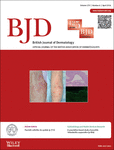

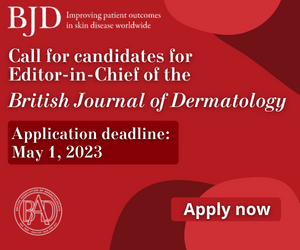
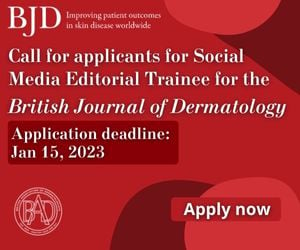

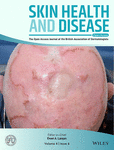
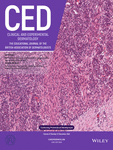
2690-442X.cover.png)